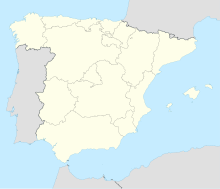Madrid Deep Space Communications Complex
Coordinates: 40 ° 25 '53 " N , 4 ° 14' 53" W.
The Madrid Deep Space Communications Complex (MDSCC) is located in a valley basin at an altitude of around 800 meters above sea level in the communities of Robledo de Chavela and Fresnedillas de la Oliva around 50 kilometers west of Madrid , Spain . MDSCC is a radio telescope system of the Deep Space Network (DSN) for tracking space probes . The complex was built in 1961 by the Instituto Nacional de Técnica Aeroespacial (INTA) in collaboration with NASA .
The MDSCC complex has a 70-meter parabolic antenna (DSS-63) and three 34-meter antennas (DSS-65, DSS-54, DSS-55).
Deactivated antennas
DSS-61
The oldest antenna DSS-61 is a 34 meter antenna. It was built as a 26-meter antenna in Robledo in 1961 and served in NASA's Mariner program in 1964 . In 1979 it was expanded to 34 meters. In 1999 it was decommissioned and from 2003 it was used for the "PARTNeR" program for training and radio astronomy.
DSS-62
DSS-62 was in operation in Cebreros from 1967 to 1981. When the 26-meter antenna was no longer needed, it was handed over to the Spanish space organization INTA and decommissioned in 1986. The former location of this antenna is now an ESTRACK location.
DSS-66
A 26 meter antenna was in Fresnedillas from 1967 to 1985. In 1985 she was dismantled and transferred to Robledo and became DSS-66, decommissioned on September 30, 2008.
Active antennas
DSS-63
The DSS-63 antenna was officially put into operation on May 14, 1974 by King Juan Carlos of Spain and at that time had a diameter of 64 meters. In 1989 it was extended to 70 meters for the rendezvous of the Voyager 2 space probe with the planet Neptune . It has receivers for L, S, X and K bands. There is a 20 kW transmitter for S and X band. It can transmit with an additional transmitter with up to 400 kW in the S and X-band, but due to a contractual agreement with SETSI, the use of the S-band transmitter in the 2110 to 2120 MHz range is waived. The antenna also has a Ku receiver for radio astronomy. The DSS-63 weighs 8000 tons, of which the antenna, which has an area of 4180 m², weighs 3500 tons.
DSS-65
The HEF antenna DSS-65 was built in 1987 and has a diameter of 34 meters. It can transmit with a transmission power of 20 kW in the S and X bands. The weight of the DSS-65 is 400 tons, with the antenna weighing 350 tons.
DSS-54
The antenna DSS-54 was built in 1997 and has a diameter of 34 meters. It can transmit with a transmission power of 20 kW in the X band and receive on the S, X and Ka bands. The weight of the DSS-54 is 358 tons. DSS-54 was designed as a beam waveguide (BWG) type (signal transmission using optical fibers ).
DSS-55
The DSS-55 antenna of the type Beam Waveguide (BWG) was put into operation in 2003 and has a diameter of 34 meters. It can transmit with a transmission power of 20 kW in the X band and receive on the X and Ka bands. The weight of the DSS-55 is 358 tons and was designed for a wind load of 160 km / h. The construction of the DSS-55 enables reliable data acquisition up to wind speeds of 64 km / h.
DSS-56 and DSS-53
Both antennas are in the planning and construction phase. DSS-56 is to go into operation in October 2019, DSS-53 in October 2020. DSS-53 is to get an 80 kW transmitter.
Missions

- Lunar Orbiter
- Apollo 11
- Viking
- Spirit
- Venus Express
- Cassini-Huygens
- Voyager 1
- Voyager 2
- Pioneer 10
- Mars Reconnaissance Orbiter
- New Horizons
Frequency ranges
| tape | service | Frequency range | |
|---|---|---|---|
| Downlink | Uplink | ||
| L. | 1.53-2.7 GHz | ||
| S. | 2.7-3.5 GHz | ||
| C. | 3.4-4.2 GHz | 5.925-6.425 GHz | |
| X | Military Komsats. | 7.25-7.75 GHz | 7.9-8.4 GHz |
| Research radio 1 | 8.4-8.5 GHz | 7.145-7.235 GHz | |
| K u (Europe) | FSS | 10.7-11.7 GHz | 12.75-13.25 GHz, 13.75-14.5 GHz |
| BSS | 11.7-12.5 GHz | 17.3-18.1 GHz | |
| SMS | 12.5-12.75 GHz | 12.75-13.25 GHz, 13.75-14.5 GHz | |
| K u (America) | FSS | 11.7-12.2 GHz | 14-14.5 GHz |
| BSS | 12.2-12.7 GHz | 17.3-17.8 GHz | |
| K a | 17.7-21.2 GHz | 27.5-31 GHz | |
| Remarks | 1 research satellites , space probes | ||
Web links
Individual evidence
- ↑ Olalla Cernuda, “La NASA, en Robledo de Chavela”, edition: El Mundo , February 13, 2004 .
- ↑ Photo inauguration DSS-63 ( Memento from August 4, 2012 in the web archive archive.today )
- ↑ NASA's Newest Deep Space Network Antenna is Operational. In: technology.org. October 12, 2016. Retrieved November 12, 2017 .
- ^ Mission Introduction to the DSN. (PDF) NASA, March 3, 2015, accessed November 11, 2018 .

